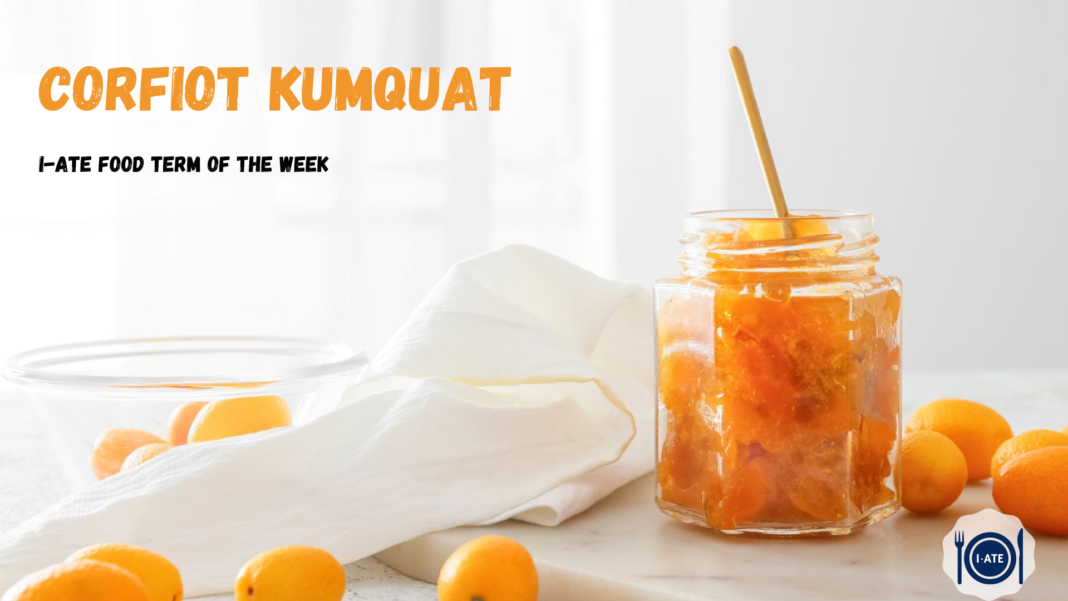If you ever get to visit Corfu Island in Greece, you definitely have to taste the island’s kumquat!
The History of Kumquat

Kumquats are most of the times described as the gems of the citrus family. They are a group of small fruit trees, classified in the Fortunella genus. Originally, the name of the fruit was spelled as cumquat or comquot, meaning gold orange in China. Accordingly, their name derives from the Cantonese kamkwat, meaning golden orange or golden tangerine. Kumquats have appeared in Europe and America since the mid-19th century, but were already mentioned in Chinese literature since 1178 AD. As a result, they are believed to be of Chinese origin.
The Greek Kumquat
Nowadays, depending on the country, there are different variants of kumquats all over the world. One of the most famous ones in Europe is the one of the island of Corfu, Greece. Corfu lies on the northwestern coast of Greece, facing the dazzling waters of the Ionian Sea. Kumquat made its first appearance in the island from China and easily adapted to Corfu’s mild climate. Rumour has it that Sidney Merlin, a botanist and athlete, first brought the fruit in Corfu in 1924. Since then, it has become an integral part and a trademark of the island’s culture and one of its most selling products. In fact, kumquat production in Corfu reaches more than 100 tonnes per year, especially in the northern part where the fruits are cultivated. In Corfu, you can find the Nymphs Agricultural and Industrial Association, which has been actively working for forty years now in the collection, production, packaging and promotion of kumquats. In addition, the Corfiot kumquat has a protected designation of origin (PDO) certification, an indication of its excellent quality.
How to consume the Corfiot Kumquat?

The Corfiot kumquat resembles oranges, but differs in taste. You can consume the entire fruit and indulge into the sweet, bitter and at the same time sour flavours it offers. Kumquat is rich in vitamin C, antioxidants and minerals and is low in calories as well, a fact that makes it an ideal snack choice if you want to follow a balanced and healthy diet. Studies have also shown that kumquat contains essential oils that have anticancer properties.
If you think that kumquat can be only consumed raw as it is, you are definitely wrong! Kumquat is widely used in order to produce fine liquors, marmalades and spoon sweets, while the locals prefer it for cooking purposes, making of syrups and meat glazes. Other than that, many companies use it for the production of perfumes, soaps and toiletries. Curious to find out one of the most delicious and well-known recipes of Corfiot Kumquat, the traditional Corfiot spoon sweet? If yes, continue reading!
Ingredients:
- Kumquats
- Water
- Lemon
- Sugar
You will only need to use four ingredients in order to prepare the unique spoon sweet that will remain unforgettable to your guests. Start by putting your kumquats in a basin full of water for three days. Make sure to change the water every day, though. Fill a big pot with water and start boiling them for at least 30 minutes. Change the water and start boiling them again for additional 30 minutes. Use a toothpick in order to check if the kumquats are soft enough and can be pierced.
It is now time for the syrup. For half a kilo of kumquat, put 750 gr of sugar and stir. Then add around two glasses of water and start boiling for a few minutes. For extra flavour, don’t forget to add few drops of lemon. After the fruits and syrup are separately ready, then it is finally time to mix them and boil them together for a couple of minutes. Depending on the quantity and thickness of the syrup, you can add water and continue boiling or add sugar, respectively.
Your spoon sweet is ready for consumption! You can eat it as it is or accompany it with walnuts, almonds or ice cream and enjoy a part of the Corfiot culinary identity!
References:
Kumquat. 2022. Kumquat. [ONLINE] Available at: https://hort.purdue.edu/newcrop/morton/kumquat.html. [Accessed 31 March 2022].
Greek Gastronomy Guide. 2022. Kumquat – Greek Gastronomy Guide. [ONLINE] Available at: https://www.greekgastronomyguide.gr/en/item/koumkouat-kerkyra/. [Accessed 31 March 2022].
My Kerkyra. 2022. Kumquat: the precious golden orange of Corfu. [ONLINE] Available at: https://www.mykerkyra.com/en/kumkquat/. [Accessed 31 March 2022].
Thelandofcorfu. 2022. KUMQUAT – Thelandofcorfu. [ONLINE] Available at: https://www.thelandofcorfu.com/kumquat-general/. [Accessed 31 March 2022].

Written by Ioanna Mavridou
Ioanna holds a Bachelor’s degree in Translation from the Ionian University in Corfu and has also studied her Master’s in Communication at Gothenburg University in Sweden. A digital communications enthusiast, she has completed a professional Social Media & Digital Marketing certification. She speaks Greek, English, Swedish, German and Russian. She is a Communications Trainee at the Terminology Coordination Unit of the European Parliament.

